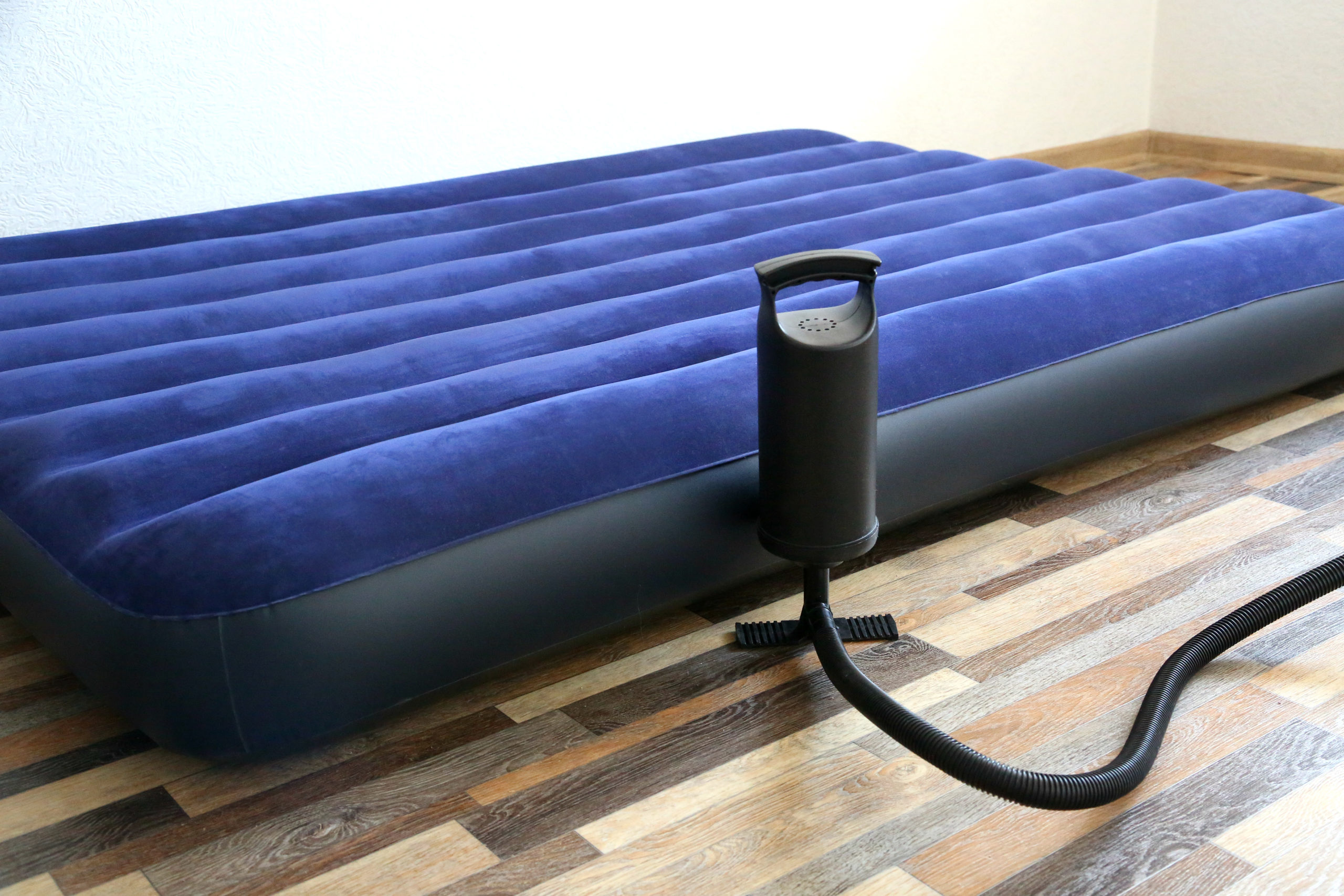An air mattress is a great option to have on hand when you’re hosting overnight guests or going on a camping trip. They’re convenient, affordable, and portable. The downside? They’re prone to leaks. Even a small air mattress leak can leave you lying flat on the ground by morning. The good news is many air mattresses can be repaired. The bad news is it can be tricky to locate the leak unless you know how to find a hole in an air mattress.
We know its tricky figuring out how to find a hole in an air mattress so we’re here to help! Read on to learn how to find a leak in an air mattress and how to patch it quickly and effectively.

Why Do Air Mattresses Lose Air?
Do you find yourself waking up flat on the floor after sleeping on an air mattress? You’re not alone. Inflatable mattresses are handy to have around but sometimes they seem like more trouble than they’re worth – especially when they deflate overnight. But what causes an air mattress to lose air?
In many cases, the problem is user error. It seems simple enough to open the valve, pump in some air, then seal it up. But if you don’t read the user manual the first time you use the air mattress you could be setting yourself up for repeated mistakes. Each air mattress is different, so it’s well worth following the instructions to make sure you inflate it properly.
Even if you inflate the air mattress properly, it will probably lose a little bit of air overnight simply because of temperature differences. As the evening cools down, the air inside the mattress condenses which may result in a loss of pressure. You can also lose air through the valves or when removing the pump to plug the valves. In cases of significant deflation, however, there’s probably a hole.
How to Find a Hole in an Air Mattress
Before you can fix a leak in an air mattress, you have to find it. The first step is to do a visible inspection of the mattress to see if you can spot any obvious holes. If not, do a more thorough inspection on the surface of the air mattress and around the valves. The valves and seams are generally the first parts of an air mattress to wear and develop leaks.
Here are some other ways to find a hole in an air mattress:
- Hand Test
Start by filling the air mattress to an appropriate level then use your hand to locate the hole. Apply a little downward pressure to squeeze out the air during the search. Start in one corner and move your hand laterally around the mattress, testing the seams. If the seams don’t seam to be the problem, test the top, sides, and bottom of the air mattress.
- Sound Test
Another option is to fill the air mattress then listen for the sound of escaping air. Again, it may help to apply some downward pressure as you move your ear around the mattress. Listen for the sound of escaping air – you’ll hear a hissing noise and may feel a rush of air against your ear. The sound of leakage will get louder the closer you are to the hole.
- Soap Test
If all else fails, the soap test should work to find even the smallest of leaks. Add a few drops of liquid dish soap to a spray bottle and fill with water. Spray some of the solution around the valve and wait to see if bubbles form. After you’ve eliminated the valve as the source of the leak, move away from it around the perimeter of the mattress, spraying as you go. Be sure to inspect the mattress at eye level so you’ll be able to spot even the smallest of bubbles as they form.
Quick Tips to Repair an Air Mattress Leak
Figuring out how to find a hole in an air mattress can be tricky, but fixing it is pretty straight forward. Many air mattresses come with a patch kit. If you can find it, your best option is to follow the instructions it came with. If you can’t find the patch kit, a bike tire patch kit will work.
Here’s how to fix an air mattress leak:
- Locate the leak and use a pen or permanent marker to mark the area.
- Clean the area around the leak using all-purpose cleaner and a clean rag.
- If your mattress has a flocked texture, moisten the area then use fine-grain sandpaper to remove the texture.
- Cut the patch material about half an inch larger than the hole on all sides.
- Apply the included adhesive generously to the patch, especially in the middle.
- Place the patch over the hole and press down firmly, rubbing in a circular motion to remove air bubbles.
- Put a heavy weight (10 pounds or more) on top of the patch and let it set for at least 8 hours.
- Remove the weight and reinflate the bed then sprinkle a little baby powder around the patched area.
- Press down on the mattress to test the patch – if the baby powder goes flying you need to reapply the patch.
If you don’t have the patch kit that came with your air mattress or a bike tire repair kit, you might be able to get by with another thin plastic material. A piece of vinyl shower curtain, for example. When it comes to choosing the right glue, super glue or contact cement are the best options.
How to Avoid Future Leaks
Once you’ve patched your air mattress, you want to make sure you don’t have to go through the process again. If properly applied, your patch should hold, and you should be able to continue using the mattress normally. To make sure you get the maximum life out of your mattress, however, you may want to start taking a little better care of it.
Here are some simple tips to keep your air mattress intact:
- Use caution when rolling or folding the mattress. When you’re putting the mattress away, avoid rolling or folding the mattress too tight – follow the folding instructions in the manual.
- Maintain temperature throughout the night. If you’re using the air mattress indoors, this shouldn’t be a problem. For outdoor use, however, you may want to wait until the air cools before filling the mattress to avoid significant temperature changes.
- Check the area before you inflate. Always check and double-check the surrounding area before you inflate your air mattress. Look for popping hazards like thumb tacks, sharp stones, or sticks. If you’re camping, don’t place the air mattress too close to a fire or other heat source.
- Lie on a flat surface. Avoid sitting or kneeling on the air mattress and make sure it’s on a flat surface. Lie flat when sleeping to evenly distribute your body weight and the resulting pressure on the mattress.
- Inflate the air mattress to the proper capacity. It may be tempting to add a little extra air to account for overnight deflation, but excess pressure could cause damage. Similarly, underinflating the mattress can cause uneven weight distribution and increase the risk for puncture.
Nobody likes a leaky air mattress but just because your inflatable bed has sprung a leak doesn’t mean it’s destined for the trash. Save yourself some money and patch the hole yourself with the tips above.
Frequently Asked Questions
How do you find a leak in an air mattress?
If you’re lucky, you’ll be able to find it with a visual inspection or by following the sound of escaping air. To narrow down your search area, place some tissue paper over one section of the mattress at a time and press down to push air out. When the air escapes, it will move the paper upward and you’ll know which section of the mattress to inspect more thoroughly.
Why does my air mattress deflate overnight?
The most obvious cause for air mattress deflating is a hole. It could also be an issue with the valve, deterioration around the seams, or simply a matter of air pressure changes overnight.
What is the fastest way to find a hole in an air mattress?
One of the quickest ways to find a hole in an air mattress is to use soapy water. Spray the soapy water on the inflated mattress and press down to force air out of the hole. Look for bubbles to form on the surface of the mattress that will lead you to the leak.
